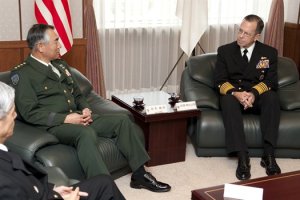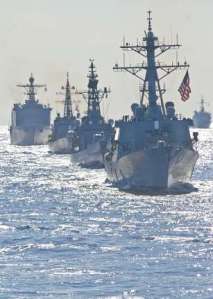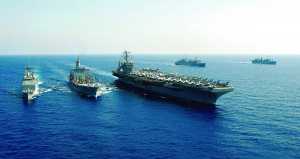By Rick Rozoff
Last week Secretary of State Hillary Clinton summoned her Japanese and South Korean counterparts, Foreign Ministers Seiji Maehara and Kim Sung-hwan, to Washington for trilateral talks on the Korean crisis in an open affront to China and Russia, which had called for a resumption of six-party discussions with both Koreas, themselves, the U.S. and Japan.
Officiating over the December 6 gathering with her junior partners on her own turf, Clinton – rather than the foreign ministers of the two East Asian nations – stated, “North Korea’s provocative and belligerent behavior jeopardizes peace and stability in Asia.” The imperial metropolis and its would-be global procurator pronounce on what constitutes threats to peace and stability on another continent; the perspective of countries in the region like China and Russia don’t need to be taken into account and their concerns don’t need to be addressed.
Admiral Mullen and General Oriki in earlier meeting
Two days later America’s top military officer, chairman of the Joint Chiefs of Staff Admiral Michael Mullen, was in the South Korean capital and in that of Japan the day after. In Seoul he met with General Han Min-koo, chairman of the South Korean Joint Chiefs of Staff, and in Tokyo with Defense Minister Toshimi Kitazawa and Japanese Self-Defense Force (JSDF) chief of staff General Ryoichi Oriki. While in Japan, Mullen mentioned “the trilateral meeting on the part of our foreign ministers which occurred earlier this week in Washington” by way of indicating that his efforts paralleled those of Clinton. Soft versus hard power in the Washington vernacular, both serving the same ends.
He also assured his Japanese opposite number General Oriki that “the United States is very much –” is very involved in regions all over the world but none so much as this one in terms of its importance and its commitment.” [1]
Keen Sword 2011
As the two top military commanders met, their armed forces were completing the eight-day Keen Sword 2011 war games which involved “units from the U.S. Army, Navy, Air Force and Marine Corps, working side-by-side with their JSDF counterparts at military bases throughout mainland Japan, Okinawa and in the waters surrounding Japan.” [2]
The exercise, the largest military undertaking conducted jointly by the two nations, included 44,000 troops, 400 aircraft and over 60 ships, including the USS George Washington nuclear-powered aircraft carrier accompanied by carrier and expeditionary strike groups.
In the words of a BBC correspondent aboard – and much enamoured with – the supercarrier, “The USS George Washington itself is like a floating city, with 5,500 men and women living on board, 60 aircraft and two nuclear reactors which could allow it to stay at sea for 25 years without coming ashore.” [3]
USS George Washington and support vessels
This year’s Keen Sword (maneuvers with that codename have been conducted since 1986) was not only the most ambitious but was highlighted as marking the fiftieth anniversary of the Treaty of Mutual Cooperation and Security between the United States and Japan, whose Article 5 mandates mutual military assistance should either country become involved in armed hostilities.
The drills were “carried out to practice for guarding against ballistic missile attacks and for defending remote Japanese islands,” [4] The first objective presumably pertains to North Korea, the second to China. [5]
The British journalist quoted earlier reminded his readers that the “joint exercises with Asian allies are…a show of strength, sending a signal that the US still has a lot of sway, not to mention firepower, in this region.
“Competition in the seas of the East Asian region is increasing. Just over the horizon from the war games are a group of islands held by Japan, but claimed by both China and Taiwan.
“The islands have untapped offshore oil and gas reserves, and these waters are a vital trade route for goods being shipped around the world.” [6]
He was referring to the island chain known as the Senkaku to Japan and the Diaoyu to China, where what may have escalated into an international incident occurred in September.
Keen Sword 2011 included drills near Okinawa, part of the Ryukyu/Nansei Islands to which Japan assigns the Senkaku Islands. It also included interceptor missile exercises the length of Japan, from Hokkaido in the north to Okinawa in the south. (Ryukyu is the designation for islands in the southern half of the chain belonging to the Okinawa Prefecture.)
Shortly after the U.S.-Japan war games ended, two members of the municipal assembly of Ishigaki in the Okinawa Prefecture “briefly set foot on one of the islands at the centre of a bitter territorial dispute between Beijing and Tokyo,” to wit Minami Kojima in the Senkaku group in the East China Sea. [7]
Before Keen Sword commenced, USS George Washington and its carrier strike group completed a four-day joint exercise with South Korea in the Yellow Sea, bordered on the north and west by China.
Along the way, the supercarrier took on board over 20 members of the Japan Maritime Self-Defense Force.
The South Korean military participated as an observer in the U.S.-Japan Keen Sword maneuvers for the first time, as Japanese military personnel observed the Invincible Spirit U.S.-South Korea war games in the Sea of Japan/East Sea from July 25-28, for which USS George Washington was also deployed.
The exercise was interrupted for several hours on December 6 when two Russian Ilyushin Il-38 anti-submarine warfare aircraft flew over U.S. and Japanese forces participating in the maneuvers and Japan scrambled F-15s to intercept them. According to a U.S. military source: “It is the second incident in as many months that some have interpreted as a potential strain on Japan-Russia relations.” [8]
“Although it is not unusual for foreign planes to try to spy on other countries’ war games, Japanese media interpreted the move as Russia’s latest warning shot in a festering territorial dispute between Moscow and Tokyo. The incident…came just two days after Japan’s foreign minister, Seiji Maehara, flew over the disputed Kuril Islands that are currently part of Russia but which Tokyo claims as its own. President Dmitry Medvedev became the first Russian leader to visit the islands in November, infuriating Japan.” [9]
The U.S. supports Japan’s position that the Southern Kurils are its so-called Northern Territories. [10]
On October 27 Hillary Clinton reiterated the U.S. commitment to honoring Article 5 of the 1960 U.S.-Japan Security Treaty in relation to the Senkaku/Diaoyu Islands dispute with China. She made the comment at a meeting in Hawaii with Japanese Foreign Minister Maehara, who of late has also manifested renewed interest in the Kuril Islands as seen above.
Her meeting with the foreign ministers of Japan and South Korea on December 6 and Admiral Mullen’s meetings with Japan’s and South Korea’s military leaders later in the week cannot be viewed apart from the above context.
While in Tokyo on December 9, Mullen said that North Korea’s “reckless behaviour…enabled by their friends in China” was the cause of the fact that “Northeast Asia is today more volatile than it’s been in much of the last 50 years.” In Seoul the day before he called on Japan, notwithstanding its constitutional prohibition against what is deemed collective self-defense and collective security, to play an active role in tripartite military exercises with the U.S. and South Korea.
After meeting with Japan’s leading defense and military officials, Mullen said “he had ‘a real sense of urgency’ about the need for Washington, Tokyo and Seoul to enhance security cooperation to deter North Korea.” [11] In his view, the participation of South Korean military observers in the U.S.-Japan Keen Sword exercise was “a terrific first step to broadening our trilateral relationship and deepening our collective readiness.” [12]
On December 11 Japan’s Asahi Shimbun newspaper reported that the government’s National Defense Program Guidelines to be released later this month, the first in six years, will announce that Tokyo is shifting its military strategy toward “a posture that can effectively deal with possible contingencies on Japan’s vulnerable southern islands and China’s growing military presence.”
Japan will assign increased importance to a “dynamic defense capability” for its armed forces, the archaically-named Self-Defense Forces (SDF).
The new military doctrine will “emphasize mobility and readiness to allow the SDF to respond to terrorist acts or an invasion of outlying islands.
“The guidelines will also raise concerns about the Chinese Navy’s rising presence in waters around Japan.”
“The proposal to create a dynamic defense capability to deal with the Chinese military presence would involve intelligence-gathering and surveillance, as well as a heightened deterrence factor by demonstrating the SDF’s high capabilities in joint training exercises with the United States.
“The guidelines will also call for a new deployment of the minimum force level of SDF members needed on the Nansei island chain between the south of Kyushu main island and Taiwan.”
The Senkaku/Diaoyu Islands contested by China are part of the Nansei/Ryukyu Islands, the entire group returned to Japan by the U.S. in 1971.
“An important point in the guidelines is improving mobility in order to deploy SDF members quickly to the Nansei island chain.
“This would involve using high-speed transport ships and transport planes to move SDF members based in northern parts of the country to the Nansei island chain.” [13]
An appendix to the guidelines includes plans to increase the nation’s submarine fleet from 16 to 22, acquire next-generation fighter jets and add to the number of Aegis class destroyers equipped with Standard Missile-3 interceptor missiles from the present four.
The Japan Maritime Self-Defense Force’s Aegis guided missile destroyers are modified versions of the American Arleigh Burke class destroyer employing the Aegis combat system. In the Japanese arsenal, Kongô class destroyers. In 2007 the JDS Kongô guided missile destroyer conducted a successful test of an American Standard Missile-3 (SM-3) Block IA interceptor against a ballistic missile off Hawaii, the first time a non-American warship launched one of the missiles in a test of the Aegis Ballistic Missile Defense System.
In October of 2009 the JS Myoko Aegis class destroyer intercepted a medium-range ballistic missile in a test off Hawaii.
Late this October the recently upgraded JS Kirishima destroyer fired an SM-3 missile 100 miles over Hawaii to bring down a ballistic missile target, a “significant milestone in the growing cooperation between Japan and the
U.S. in the area of missile defense.” [14]
Commenting on Japan’s new military blueprint, the New York Times revealed that the country’s “sweeping overhaul of its cold war-era defense strategy” will be released as “the United States is making new calls for Japan to increase its military role in eastern Asia in response to recent provocations by North Korea as well as China’s more assertive stance in the region.”
“The United States has used Japan’s concerns as an opportunity to strengthen ties with the country, its largest and most important Asian ally, and to nudge Japan toward a more active role in the region. In particular, Washington has proposed stronger three-way military ties that would also include its other key regional ally, South Korea.”
“Japan has slowly begun to shed some of the postwar [restrictions] against a larger Asian role for its military, known as the Self-Defense Forces, one of the largest and most technologically advanced in the region.”
“In another sign of growing coordination, South Korea’s vice minister of defense, Lee Yong-gul, visited Tokyo late last week for talks with his Japanese counterpart, Kimito Nakae, on increasing bilateral cooperation.” [15]
The Financial Times stated: “Defence policy guidelines set to be unveiled by Tokyo this month…will signal a historic refocusing of Japan’s army and other forces toward securing islands in the southern Nansei chain that are seen as threatened by China’s rapidly growing military power.”
“Tokyo has already deployed more advanced fighters to the southern island of Okinawa and beefed up army units there, but China’s deployment of new submarines, supersonic anti-ship missiles and advanced fighters is seen as challenging US and Japanese military superiority in an area that includes sea lanes vital to the trade-dependent economy.”
In regards to the Senkaku/Diaoyu Islands, the British daily added: “Early steps are likely to include new island radar stations, with small army units to guard them. Some analysts say anti-ship missiles should later be deployed along the Nansei chain to support naval forces in the area.” [16]
On December 11 Kyodo News cited a draft appendix to the new defense policy guidelines in reporting that Japan will be “equipping all [its] six Aegis destroyers with Standard Missile-3 interceptors” and that “Patriot Advanced Capability-3 interceptor missiles will be deployed at air bases nationwide.”
The news source also disclosed that the “PAC-3 missile system, designed to shoot down an incoming missile from the ground moments before reaching its target, will be deployed by all six Air Self-Defense Force air-defense missile groups from three at present.” [17]
In fact, Japanese disarmament activists have identified twelve air bases where Patriot Advanced Capability-3 missiles have already been installed: Those at Aibano, Ashiya, Gifu, Hakusan, Hamamatsu, Iruma, Kasuga, Kasumigaura, Narashino, Takaradai, Takeyama and Tsuiki. [18] The U.S. also has a Patriot battery at the Kadena Air Base on Okinawa.
Japan’s white paper is similar to that of Australia’s of last year, “Defending Australia in the Asia Pacific century: force 2030,” [19] which details the nation’s largest military buildup – at a price tag of $72 billion – since the Second World War, and New Zealand’s of last month, which advocates “closer military relations with the United States, Australia, Britain and Canada, as well as enhanced front-line capabilities.” [20]
In all three cases nations tied to the U.S. through Cold War-era defense treaties are expanding the sophistication and breadth of their military forces in the Asia-Pacific area. Shortly after Secretary of State Clinton, Secretary of Defense Robert Gates and chief of the Joint Chiefs of Staff Michael Mullen visited his country last month, Australian Foreign Minister Kevin Rudd, until last summer his nation’s head of state, asserted that “Australia could be drawn in to any military conflict on the Korean peninsula under its alliance with the US.” That is, because of obligations imposed by the Australia, New Zealand, United States (ANZUS) Security Treaty. [21]
North Korea only goes so far in serving as the justification for the expansion of expeditionary military capabilities and deeper integration with the Pentagon’s plans for the region.
The Washington-Tokyo-Seoul military axis is preparing for war. And not only on the Korean Peninsula.
1) Joint Chiefs of Staff, December 9, 2010
2) U.S. Seventh Fleet, December 3, 2010
3) Alastair Leithead, Strength and power in seas off Japan
BBC News, December 13, 2010
http://www.bbc.co.uk/news/world-asia-pacific-11980866
4) Kyodo News, December 3
5) U.S. Supports Japan, Confronts China And Russia Over Island Disputes
Stop NATO, November 4, 2010
click here
6) BBC News, December 13, 2010
7) Radio Netherlands, December 11, 2010
8) Stars and Stripes, December 8, 2010
9) Daily Telegraph, December 8, 2010
10) U.S. Supports Japan, Confronts China And Russia Over Island Disputes
Stop NATO, November 4, 2010
click here
11) Voice of America News, December 9, 2010
12) Stars and Stripes. December 9, 2010
13) Defense policy shifting focus to China’s military
Asahi Shimbun, December 11, 2010
http://www.asahi.com/english/TKY201012100382.html
14) Global Security Newswire, October 30, 2010
15) Martin Fackler, Japan Plans Military Shift to Focus More on China
New York Times, December 12, 2010
click here
16) Mure Dickie, Japan to shift military towards China threat
Financial Times, December 13, 2010
click here=rss#axzz180pgiKEu
17) Kyodo News, December 11, 2010
18) click here
19) Australian Military Buildup And The Rise Of Asian NATO
Stop NATO, May 6, 2009
click here
20) Obama, Gates And Clinton In Asia: U.S. Expands Military Build-Up In The
East
Stop NATO, November 7, 2010
click here
21) North Korea As Pretext: U.S. Builds Asian Military Alliance Against China
And Russia
Stop NATO, December 3, 2010
click here
Author’s Bio: Rick Rozoff has been involved in anti-war and anti-interventionist work in various capacities for forty years. He lives in Chicago, Illinois. Is the manager of the Stop NATO international email list at: http://groups.yahoo.com/group/stopnato/



